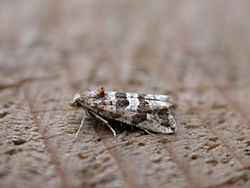Lobesia littoralis facts for kids
Quick facts for kids Lobesia littoralis |
|
|---|---|
 |
|
| Scientific classification | |
| Kingdom: | |
| Phylum: | |
| Class: | |
| Order: | |
| Division: | |
| Section: |
Cossina
|
| Family: | |
| Genus: |
Lobesia
|
| Species: |
L. littoralis
|
| Binomial name | |
| Lobesia littoralis (Westwood & Humphreys, 1845)
|
|
Lobesia littoralis is a small moth that belongs to the Tortricidae family. You can find this moth along the coasts of Europe. It lives wherever its favorite food plants grow. This includes places like the Faroes, Iceland, and St Kilda.
Contents
About the Lobesia littoralis Moth
The Lobesia littoralis moth is quite small. Its wingspan (the distance from one wingtip to the other) is about 11 to 16 millimeters. That's roughly half an inch!
What the Moth Looks Like
The front wings, called forewings, are long and narrow. They are usually a pale yellowish-brown or light grayish-yellow color. Sometimes, they might have a slight pinkish tint. You might also see faint lines on them.
Near the base of the forewings, there's a darker patch. This patch can be a deeper color or reddish-brown. It often has black marks near the bottom edge. There's also a narrow band in the middle of the wing and another band at the very end. These bands are also darker or reddish-brown and sometimes have black spots.
The back wings, called hindwings, are a pale gray. They get a bit darker towards the tips.
Life Cycle of the Moth
Adult Lobesia littoralis moths are active from late May until October. They usually have two generations born each year. These moths like to fly in the late afternoon sun. They are also attracted to lights at night.
You can spot them in different coastal areas. They live on rocky coastlines, in saltmarshes (grassy areas flooded by saltwater), and on vegetated shingle (beaches with small, smooth stones and plants). Sometimes, they even visit gardens!
What the Larvae Eat
The young moths, called larvae (or caterpillars), are usually pale greenish-gray. Some can be dark brown. Their heads are light brown.
These larvae love to eat two main plants:
- Thrift (Armeria maritima)
- Birds-foot trefoil (Lotus corniculatus)
The larvae from the first generation eat unripe seeds inside the flowerheads. They also munch on young shoots. They spin a silky tube among the leaves to live in. The larvae from the second generation feed on seeds found in the dead flowerheads.
The Pupa Stage
After the larva stage, the moth enters the pupa stage. The pupa is light olive-brown. It forms inside a strong, white silky cocoon. You can find these cocoons in a flowerhead or among the leaves of the plant the larva ate.
See also
 In Spanish: Lobesia littoralis para niños
In Spanish: Lobesia littoralis para niños

